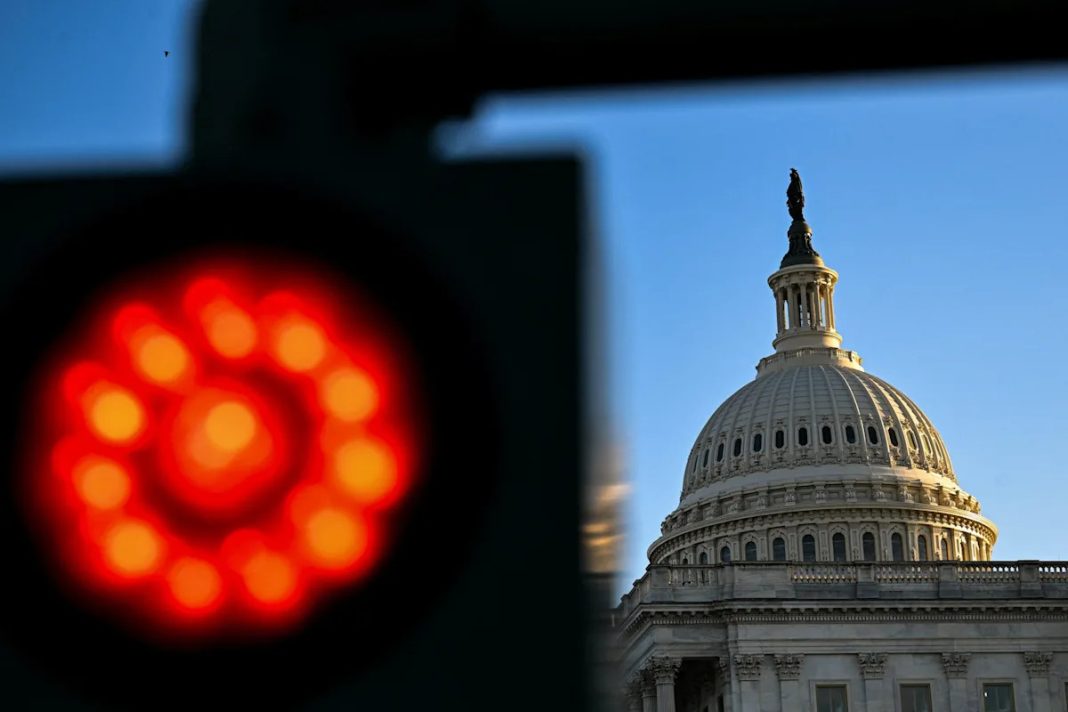And on the fifth day, nobody rested.
Not that Washington was consumed on Oct. 5 with trying to reopen up the federal government. The Sunday airwaves were afire instead with efforts to assign the blame.
While budget showdowns have headed off this fiscal cliff before, today’s version is the nuclear war of shutdowns – with more explosive impact on the government and more intense incentives to keep it going.
House Democratic leader Hakeem Jeffries of New York called President Donald Trump‘s tactics during the shutdown “outrageous” and “unhinged.”
“The American people deserve better than lies, than attacks, than deep-fake videos and the president spending all of his time on the golf course,” he said on NBC’s “Meet the Press.” “We need serious leadership.”
But House Speaker Mike Johnson replied that Democrats were responsible for empowering the administration to cut federal jobs and freeze grants.
“In a situation like this, where the Senate Democrats have decided to turn the keys to the kingdom over to the White House, they have to make tough decisions,” the Louisiana Republican told NBC. He said Russell Vought, director of the Office of Management and Budget, now has to “determine what are essential programs, policies, and personnel. That’s not a job that he relishes. But he’s being required to do it by Chuck Schumer.”
Neither side sounded like compromise was in the air. Indeed, Johnson has recessed the House for the week.
Trump: An ‘unprecedented opportunity’ to wield power
In the past half-century, every president except George W. Bush and Joe Biden has weathered shutdowns of at least a few days. During their tenures, Bill Clinton, Jimmy Carter and Barack Obama all saw shutdowns of more than two weeks.
The 35-day record was set during Trump’s first term; the shutdown ended when he folded on demands for more funds to build a wall along the southern border.
The current shutdown isn’t nearly the longest − at least, not yet − but it’s already scoring the most far-reaching, substantive impact of any of them. In the sweeping efforts during his second term to expand the powers of the presidency, Trump has seized the opportunity of the shutdown to threaten layoffs of federal workers and freeze billions of dollars in federal grants to predominantly Democratic states.
“I can’t believe the Radical Left Democrats gave me this unprecedented opportunity,” the president crowed on social media.
A view of a sign warning that the U.S. Capitol Visitor Center is closed, with the U.S. Capitol dome visible in the background, on the first day of a partial government shutdown, in Washington, D.C., U.S., October 1, 2025.
That might help explain why Trump hasn’t rushed into extended talks with Democratic congressional leaders to negotiate a deal. “Donald Trump is in the presidential witness protection program,” Jeffries complained. “No one can find him.”
As the shutdown loomed, Trump told reporters he might fire “vast numbers” of federal workers, rather than simply furloughing them as in past shutdowns. He vowed to target “Democrat things” and “Democrat Agencies.”
Amid the shutdown’s early days, his administration has frozen $18 billion in federal funding for major infrastructure projects in New York City, put on hold $2.1 billion in funding for Chicago transit projects and cut nearly $8 billion in Energy Department grants in 16 states.
All those states were carried by Democratic nominee Kamala Harris in the 2024 presidential election, by the way.
For Democrats, complicated political calculations
For Democrats, too, some of the incentives today are to fight, not compromise.
The party’s core supporters have soured on their congressional leaders for failing to effectively stand up to Trump during the dizzying opening months of his second term, when he has claimed unprecedented authority to fire agency heads, push for investigations of his political enemies and take from Congress traditional powers over spending.
In an NPR/Marist Poll taken in late September, fewer than half of Democratic voters, 48%, approved of the job congressional Democrats were doing. In contrast, 87% of Republicans approved of the job the congressional GOP was doing.
What’s more, Democratic voters are increasingly spoiling for a fight: 47% said it was more important for members of Congress to stand on principle, even if it meant a government shutdown. That’s a sea change from polling before the 2013 shutdown when Democrats by 4-1 backed compromise.
When Senate Minority Leader Chuck Schumer avoided a shutdown in May, he faced a blast of protests from the party’s most liberal voices and speculation that New York Rep. Alexandria Ocasio-Cortez might challenge his reelection campaign in 2028.
So far this time, his tone has been unyielding.
“Well, look, there’s a lot of difference between now and then,” Schumer said on CNN, blasting the GOP’s stance as “outrageous” and “bull.” Democrats are demanding Medicaid cuts be restored and health care subsidies be extended; Republicans say they won’t negotiate during the shutdown. “They seem to care more about protecting the Epstein files than protecting the American people and their health care.”
While early polling by news organizations showed Americans placing more blame for the shutdown on Republicans than Democrats, the margins weren’t overwhelming. Nearly 1 in 4 said they weren’t sure who to hold responsible.
But about 1 in 3 said they had decided: They blamed both sides.
This article originally appeared on USA TODAY: The nuclear war of shutdowns targets federal jobs, grants

